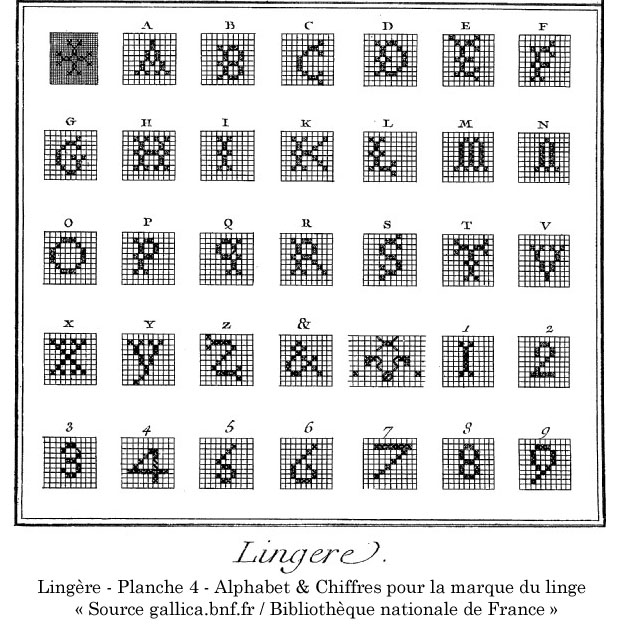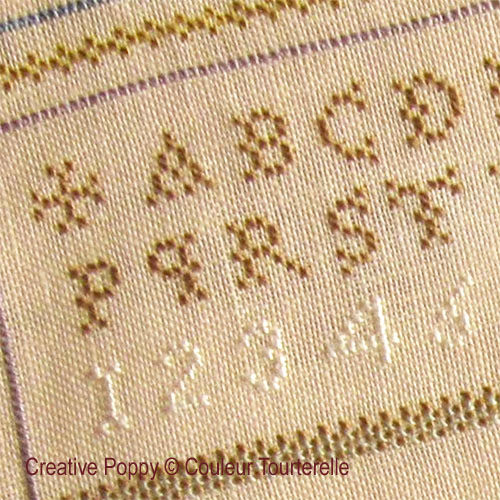Couleur Tourterelle - Reproduction samplers by Meriem Chauvet
>> back to Latest pattern news
A rare cathedral and a wonderful story by Couleur Tourterelle
Meriem Chauvet, Couleur Tourterelle's designer always amazes us with the discoveries she makes, just by observing a sampler - closely it must be said because she spots the smallest capricious cross stitch - and digging through archives . One of her recent finds is a cathedral stitched in 1841 byFlorentine Picard. She learns there isn't one but two twin samplers and goes on to tell us the story of two little French country girls living in neighboring villages, stitching two almost identical samplers a few months apart. What a wonderful story a sampler can tell!
The 2nd sampler presented here, that of Maria S, is not stitched by Maria Sadella as would appear, but by a 11-year-old girl, with an anonymous surname. The two samplers, stitched 13 years apart, have interesting points in common.
New finds by Couleur Tourterelle, including a sampler stitched and signed by 18 young girls
Meriem Chauvet's collection of antique samplers has been recently enriched with two antique French finds, including quite an exceptional sampler. Thanks to the painstaking efforts of Couleur Tourterelle's designer, cross stitch charts are available for any stitcher to reproduce those little gems.
The first work is a cute little sampler, probably stitched by a very young one, balancing traditional motifs and ones that would appeal to a child.
The second sampler is remarkable, by its width of course, but especially because it was stitched and individually signed by 18 young girls, all students of the class of Madame Tougas, in a rural school in Normandy. The piece features 8 large cross stitch alphabets, some of which denote the influence of Art Nouveau - the work was completed in 1904 - and is a true masterpiece and witness to its time.
Two new reproduction samplers by Couleur Tourterelle
The first sampler is from England and features a psalm. It has a particularly elongated shape.
and one of Spanish origin - almost monochrome except for two tiny touches of color. This one is by contrast a long band.
In search of Lost Time
This sampler was stitched as a keepsake of a young girl's stay in the Normandy seaside resort of Cabourg. The place is famously known as one of the setting of Marcel Proust's literary work "In search of Lost time" including "In the shadow of young girls in Flower". We do not know the young stitcher's age, but she might have come across Marcel who also sojourned as a boy with his parents in the 1880's, long before he would become a famous writer.
Hortense de Frocourt proudly signs her name on the sampler, repeating her initials in several places. There is great elegance in the way the sampler is composed and the choice of letters and motifs. The little steamboat motif, a reminder of the seaside location, would at the time have been considered a "modern ship" as opposed to a sailboat.
"Marquette" and "Marquoir"
For the word "Sampler" in English, the French language distinguishes two types of needlework. This work (left), about 20 earlier than the one above, is the more simple marquette, probably the first work of a young stitcher, using a single color on rustic linen fabric. Originally marquettes consisted of just letters and numbers stitched for practice. This one however was embellished with four elegant borders and the young stitcher was able to personalize her work with some motifs of her own.
The reproduction sampler (right) was turned into a tiny pin-cushion by Meriem Chauvet (stitched over 1 thread on finer fabric). The chart however is the exact reproduction of the original.
The linen maid's alphabet & numbers
The tradition of "marking" household linen goes back at least a century further before that and was already cited in the encyclopaedia published by Diderot and d'Alembert between 1751 and 1772. The image below is an extract of the original illustration of the Linen maid's Alphabet & Numbers, left (source: gallica.bnf.fr / BNF).
The alphabet was passed on from generation to generation as can be seen in the E. Loir Sampler where every letter and number is replicated in the exact same format (notice the shape of number 5)
 | | Original illustration from the Diderot and d'Alembert Encycopaedia (left) | Detail of E. Loir Reproduction Sampler (right) |
|  |
An 1823 poem dedicated to a beloved grand-mother
While many English language samplers include long texts - often scripture or prayers - French samplers rarely include any text beyond a couple of words.
This sampler dating back to 1823 (original pictured left) is an exception: a poem composed by a 9 year-old stitcher expressing her love for her beloved grand mother, maybe the person who taught her to stitch. As the young girl was born in 1814, the grandmother must have lived through the 1789 French revolution and Napoleonic reign. Notice the typographical style and simple ornamentation characteristic of the period.
The Catholic church in 19th century samplers
After the revolutionary times, the Catholic church regained its huge influence in France. By contrast with the work previously shown, the church altar - be it surrounded with flowers - was often a prominent theme in samplers and could be depicted in intricate detail.
The three examples below show to which extent: with the first one implying an altar by its layout, the second depicting the interior of the church in amazing detail, and the third one - probably a personal interpretation - replacing the center altar with a monumental basket of flowers and adding more fantasy, birds in particular.
Wool and color
Later samplers tend to be more personal, including birds and other ornamental motifs. With wool thread gradually replacing silk, samplers feature a larger number and brighter colors. Here are some examples of colorful samplers of the second half of the 19th century in France
and an example of a Dutch Sampler of the same period
Tapestry motifs
The sampler is representative of late 19th century European samplers where richly colored tapestry designs were starting to be published and stitchers picked motifs of their choice to embellish their samplers. This stitcher, living in a rural part of France, picked several motifs for her sampler, a lady and a gentleman in 18th century attire, as well as two parrot motifs.
Early 20th century
This relatively "modern" sampler features a very interesting mix of early 20th century styles.
The top part of the sampler features a single alphabet with large elaborate monogram letters similar to those seen in white embroidery.
The two charming bird motifs, as well as the central motif are certainly stitched from one of the models popular at the time.
And surrounding the sampler is a remarkable Art nouveau border. It is stitched in pink, with very dark flowers and long protruding pistils.
This shows the remarkable way stitchers have been able to follow the needlework trends of their times, yet at the same time producing some very personal and remarkable works.
More Reproduction samplers by Couleur Tourterelle 
Couleur Tourterelle - Reproduction sampler patterns are now available as instant downloadable patterns, on Creative Poppy's website.
The easy-to-read charts come both as Black & White AND Color charts. They include a digital friendly one page chart ideal for reading on a digital device.
All charts feature a photograph and description of the original sampler, and offer several options for stitching the reproduction either close to the original, or in other threads and fabric counts.
There are more Reproduction samplers by Couleur Tourterelle available on Creative Poppy's website, and many more to be added soon.
>> see all Reproduction samplers by Couleur Tourterelle
>> Back to Latest pattern news